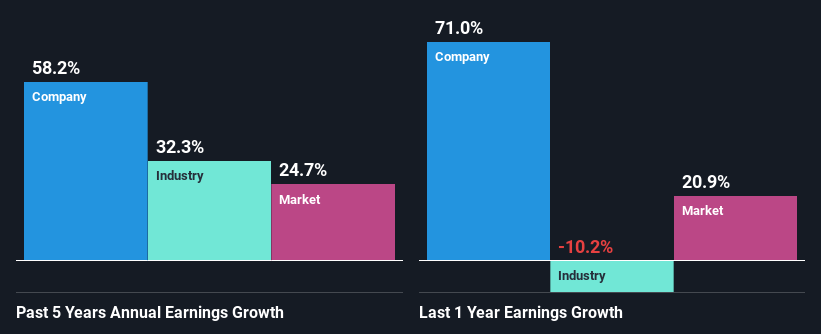- India
- /
- Renewable Energy
- /
- NSEI:KPIGREEN
Will Weakness in KPI Green Energy Limited's (NSE:KPIGREEN) Stock Prove Temporary Given Strong Fundamentals?
With its stock down 4.5% over the past week, it is easy to disregard KPI Green Energy (NSE:KPIGREEN). However, stock prices are usually driven by a company’s financial performance over the long term, which in this case looks quite promising. In this article, we decided to focus on KPI Green Energy's ROE.
Return on equity or ROE is an important factor to be considered by a shareholder because it tells them how effectively their capital is being reinvested. In other words, it is a profitability ratio which measures the rate of return on the capital provided by the company's shareholders.
View our latest analysis for KPI Green Energy
How Do You Calculate Return On Equity?
ROE can be calculated by using the formula:
Return on Equity = Net Profit (from continuing operations) ÷ Shareholders' Equity
So, based on the above formula, the ROE for KPI Green Energy is:
12% = ₹2.3b ÷ ₹20b (Based on the trailing twelve months to September 2024).
The 'return' is the profit over the last twelve months. So, this means that for every ₹1 of its shareholder's investments, the company generates a profit of ₹0.12.
Why Is ROE Important For Earnings Growth?
Thus far, we have learned that ROE measures how efficiently a company is generating its profits. Depending on how much of these profits the company reinvests or "retains", and how effectively it does so, we are then able to assess a company’s earnings growth potential. Assuming all else is equal, companies that have both a higher return on equity and higher profit retention are usually the ones that have a higher growth rate when compared to companies that don't have the same features.
KPI Green Energy's Earnings Growth And 12% ROE
At first glance, KPI Green Energy's ROE doesn't look very promising. However, the fact that the its ROE is quite higher to the industry average of 8.0% doesn't go unnoticed by us. Especially when you consider KPI Green Energy's exceptional 58% net income growth over the past five years. Bear in mind, the company does have a moderately low ROE. It is just that the industry ROE is lower. So, there might well be other reasons for the earnings to grow. For example, it is possible that the broader industry is going through a high growth phase, or that the company has a low payout ratio.
As a next step, we compared KPI Green Energy's net income growth with the industry, and pleasingly, we found that the growth seen by the company is higher than the average industry growth of 32%.

The basis for attaching value to a company is, to a great extent, tied to its earnings growth. It’s important for an investor to know whether the market has priced in the company's expected earnings growth (or decline). By doing so, they will have an idea if the stock is headed into clear blue waters or if swampy waters await. One good indicator of expected earnings growth is the P/E ratio which determines the price the market is willing to pay for a stock based on its earnings prospects. So, you may want to check if KPI Green Energy is trading on a high P/E or a low P/E, relative to its industry.
Is KPI Green Energy Making Efficient Use Of Its Profits?
KPI Green Energy has a really low three-year median payout ratio of 4.2%, meaning that it has the remaining 96% left over to reinvest into its business. This suggests that the management is reinvesting most of the profits to grow the business as evidenced by the growth seen by the company.
Moreover, KPI Green Energy is determined to keep sharing its profits with shareholders which we infer from its long history of three years of paying a dividend.
Conclusion
On the whole, we feel that KPI Green Energy's performance has been quite good. Particularly, we like that the company is reinvesting heavily into its business at a moderate rate of return. Unsurprisingly, this has led to an impressive earnings growth. If the company continues to grow its earnings the way it has, that could have a positive impact on its share price given how earnings per share influence long-term share prices. Remember, the price of a stock is also dependent on the perceived risk. Therefore investors must keep themselves informed about the risks involved before investing in any company. Our risks dashboard would have the 2 risks we have identified for KPI Green Energy.
Valuation is complex, but we're here to simplify it.
Discover if KPI Green Energy might be undervalued or overvalued with our detailed analysis, featuring fair value estimates, potential risks, dividends, insider trades, and its financial condition.
Access Free AnalysisHave feedback on this article? Concerned about the content? Get in touch with us directly. Alternatively, email editorial-team (at) simplywallst.com.
This article by Simply Wall St is general in nature. We provide commentary based on historical data and analyst forecasts only using an unbiased methodology and our articles are not intended to be financial advice. It does not constitute a recommendation to buy or sell any stock, and does not take account of your objectives, or your financial situation. We aim to bring you long-term focused analysis driven by fundamental data. Note that our analysis may not factor in the latest price-sensitive company announcements or qualitative material. Simply Wall St has no position in any stocks mentioned.
About NSEI:KPIGREEN
KPI Green Energy
Operates as an independent power producer that focuses on the development, construction, ownership, operation, and maintenance of renewable energy projects under Solarism brand name in India.
Solid track record with excellent balance sheet.
Similar Companies
Market Insights
Community Narratives



